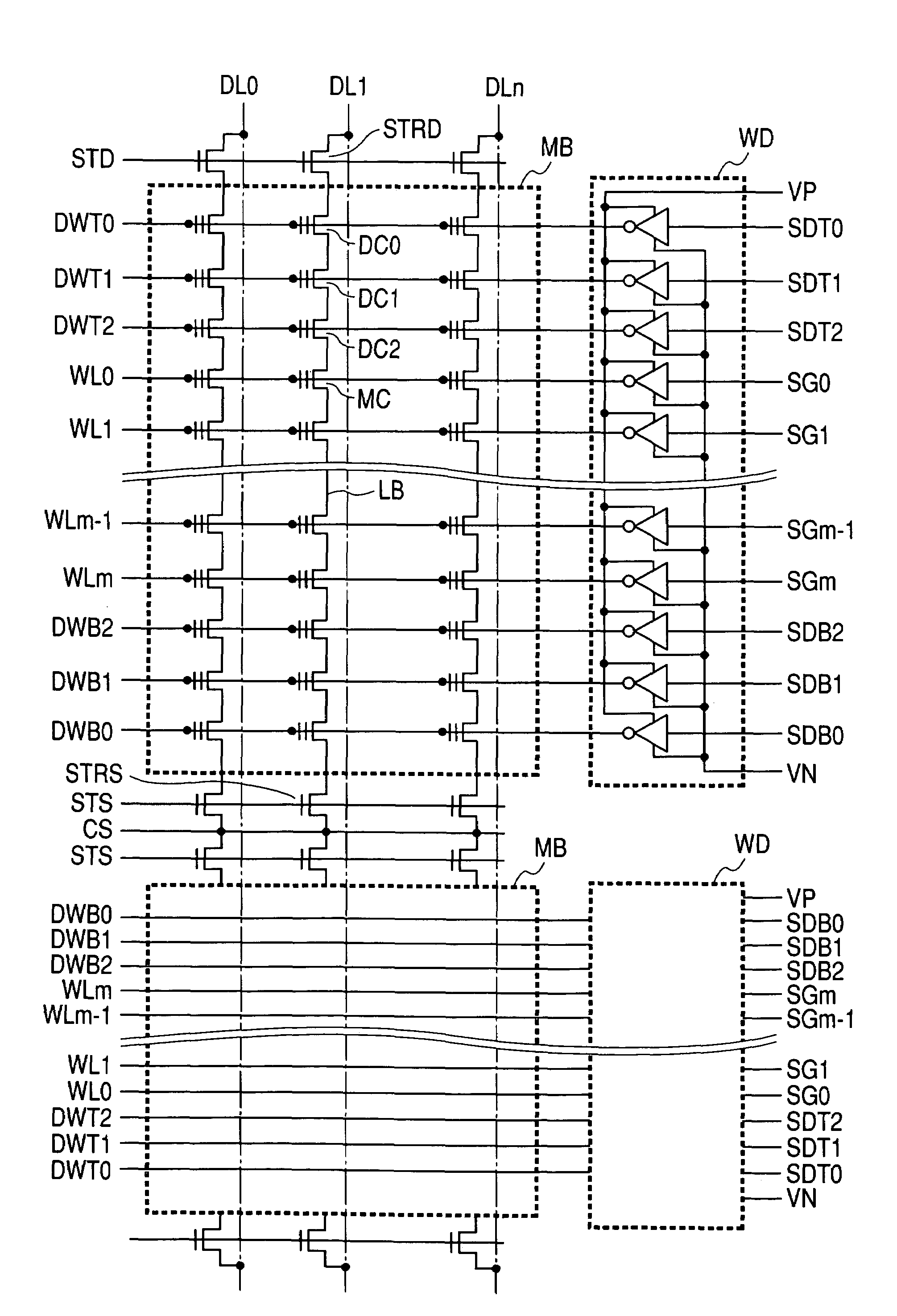Semiconductor memory device comprising controllable threshould voltage dummy memory cells
a memory cell and semiconductor technology, applied in static storage, digital storage, instruments, etc., can solve the problems of low patterning precision, unstable wlm at both ends of a memory block, and defect detection, so as to reduce the width of a word line, suppress a defect, and improve yield
- Summary
- Abstract
- Description
- Claims
- Application Information
AI Technical Summary
Benefits of technology
Problems solved by technology
Method used
Image
Examples
first embodiment
[0068]FIG. 4 illustrates a semiconductor memory device according to a first embodiment of the invention. A memory cell array shown in FIG. 4 has a hierarchical bit line structure. A memory block MB in the diagram may be of the AND cell type or the NAND cell type. The memory block MB is different from a conventional AND type or NAND type memory block is with respect to the point that dummy word lines DWT0 to DWT2 and DWB0 to DWB2 are provided on the outside of word lines WL0 to WLm. There is the possibility that the patterning precision of a word line pattern disposed at an end of the memory block deteriorates and, particularly, the width of the second word line from the end decreases. Consequently, by disposing dummy word lines on the outside of the word lines in the memory block as shown in FIG. 1, word lines in a memory cell part (hereinbelow, memory cell body) in which external data is actually stored (hereinbelow, memory cell body) can be patterned with high precision. By dispos...
second embodiment
[0076]A second embodiment of the present invention will be described with reference to FIG. 10.
[0077]FIG. 10 is the same as FIG. 5 except that the memory cells in the memory block MB are NAND cells connected in series. The memory block is different from a conventional NAND cell type memory block with respect to the point that the dummy word lines DWT0 to DWT2 and DWB0 to DWB2 are provided on the outside of the word lines WL0 to WLm. Since there is the possibility that patterning precision of a word line pattern disposed at an end of a memory block decreases and, particularly, the second word line from the end is narrowed, if dummy word lines are disposed on the outer sides of the word lines in the memory block as shown in FIG. 10, word lines (hereinbleow, called main word lines) in the memory cell part (hereinbelow, main memory cells) for actually storing external data can be patterned with high precision. By disposing three dummy word lines on each of the outer sides of the word li...
third embodiment
[0086]A third embodiment of the present invention will be described with reference to FIGS. 12 and 13. In the first embodiment of the present invention, the case where memory cells are formed under the dummy word lines likewise under the main word lines has been described. In the third embodiment, the case where memory cells are not formed under the dummy word lines will be described in detail. FIG. 13 is a top view of a portion of connection to the data lines in the embodiment. The dummy word lines DWT0 to DWT2 are disposed between the select transistor gate signal line STD and the main word line WL0. By disposing three dummy word lines on each of the outer sides of the word lines, for example, even if the second dummy word lines DWT1 and DWB1 from the ends are broken due to reduction in width, short-circuit occurs in any of the dummy word lines DWT0, DWT2, DWB0, and DWB2. Short-circuit does not occur in the word lines in the memory cell part for actually storing external data, so ...
PUM
 Login to View More
Login to View More Abstract
Description
Claims
Application Information
 Login to View More
Login to View More - R&D
- Intellectual Property
- Life Sciences
- Materials
- Tech Scout
- Unparalleled Data Quality
- Higher Quality Content
- 60% Fewer Hallucinations
Browse by: Latest US Patents, China's latest patents, Technical Efficacy Thesaurus, Application Domain, Technology Topic, Popular Technical Reports.
© 2025 PatSnap. All rights reserved.Legal|Privacy policy|Modern Slavery Act Transparency Statement|Sitemap|About US| Contact US: help@patsnap.com



